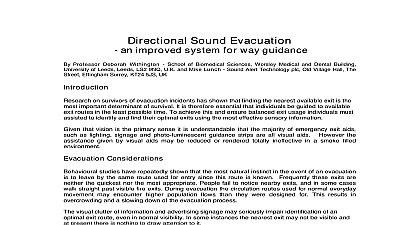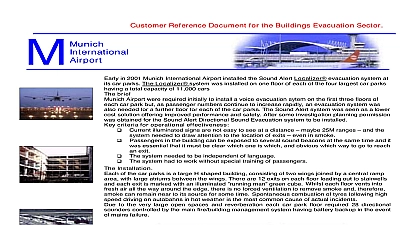System Sensor Directional Sound Localizable Alarms

File Preview
Click below to download for free
Click below to download for free
File Data
| Name | system-sensor-directional-sound-localizable-alarms-1789246053.pdf |
|---|---|
| Type | |
| Size | 600.60 KB |
| Downloads |
Text Preview
Localisable Alarms J WITHINGTON University of Leeds from Human Factors in Auditory Warnings Edited by Neville A Stanton Judy Edworthy by Ashgate Publishing Ltd 1999 0 291 39849 9 ability to localise a sound source is an evolutionary prerequisite for animals including humans For example when hearing the crack of a twig as a predator approaches there is simply not to wait and look around to check where the sound is coming from To survive an animal must instantly as soon as the audible signal is received Similarly for predators a rustle of leaves may where their potential prey is hiding and locating that position will determine whether or not eat on that occasion It is therefore safe to conclude that pinpointing sound is something we do In reality we can localise a sound to an accuracy of about five degrees given the right type of Makous and Middlebrooks 1990 This level of accuracy is less than that for visual spatial but more than adequate for survival purposes is one particular part of our central nervous system that plays a vital role in the detecting of equally importantly the response to a sound source This area is part of the mid brain and is called superior colliculus SC Stein and Meredith 1993 The SC also responds to light and touch for King 1990 The implications of this multimodality will be discussed later in the chapter with to combining light and sound in emergency egress systems Events that happen in the SC all subconsciously and depending upon the type of stimulus will elicit an orienting reaction either or away from the stimulus source Sahibzada et al 1986 studying the properties of neurones in the SC together with psychoacousticians human responses to sound have enabled us to understand how the brain processes information to a sound source and importantly what type of sound is needed for a degree of accuracy to be It has long been recognised that localising a sound source requires a vast amount of neural Knudsen et al 1987 Only certain types of sounds are inherently localizable and what is is that they contain a large spectrum of frequencies that is broadband noise Pure tones simple combinations or narrowband noise cannot be localised To understand why this is the case the given by sound that the brain can recognise must be considered can hear a vast range of frequencies from approximately 20Hz to 20kHz although this range as we age There are three main types of information that allow the brain to localise sound first two are known as binaural cues because they make use of the fact that we have two ears by the width of our head A sound which emanates from either side of the mid line will arrive at the ear closest to it and will also be loudest at the ear closest to it At low frequencies the brain differences in the time of arrival of the sound between the ears and at higher frequencies the cue is the loudness intensity difference between the sound at each ear The use of these two of cue is known as the duplex theory and was proposed by Lord Raleigh as long ago as 1877 single frequencies these cues are however spatially ambiguous The inherent ambiguity has described as the cone of confusion and this arises from the fact that for any given frequency there numerous spatial positions that generate identical timing intensity differences and these can be represented in the form of a cone the apex of which is at the level of the external ear The of confusion is the main reason for our not being able to localise pure tones Blauert 1997 and Kistler 1993 final main piece of information processed by the brain regarding sound localization is called the transfer function HRTF Carlile and King 1993 The HRTF refers to the effect the ear has on sound As a result of passing over the bumps or convolutions of the pinna the is modified so that some frequencies are attenuated and others are amplified Although there are generalities in the way the sound is modified by the pinnae the HRTF of any one person is to that individual The role of the HRTF is particularly important when we are trying to whether a sound is immediately in front of or directly behind us In this instance the timing intensity differences are negligible and there is consequently very little information available to the nervous system on which to base a decision of in front or behind So to locate the direction of sound source the larger the frequency content to overcome the ambiguities inherent to single tone the better the accuracy that we need a multi frequency sound for localization how can this be combined with our to use sound as an alarm There are a myriad of different uses for sound in alarms and in some the addition of a localisability component would be superfluous However there are other alarms in the lack of localisability directionality is potentially highly dangerous An excellent example of the is the siren used by emergency vehicles Withington and Chapman 1996 An everyday occurrence the majority of drivers is the sound of an emergency vehicle siren whether from an ambulance police or fire appliance When the emergency siren is heard drivers look all around trying to determine from direction the sounds are coming The visual cue is required because the sound alone gives no clue as which direction the vehicle is coming from The driver is not able to take appropriate avoiding action the emergency vehicle is seen often too late to allow a clear path to be created for the emergency The uncertainty regarding the direction of approach costs lives Any improvement in the sound of the siren which enables road users to take earlier evading action would both reduce the journey and enhance the safety for emergency vehicles attending emergencies and thus strengthen the service It would also be safer for road users pedestrians and drivers alike in determining the direction from which emergency vehicle sirens are approaching are widely In fact the emergency vehicle siren has been described as an extremely limited audible device De Lorenzo and Eilers 1991 A recent study in the Annals of Emergency Medicine has that an ambulance is most susceptible to collisions with other vehicles when crossing road junctions happens primarily because the drivers of the cars or trucks are unable to determine accurately the of the approaching ambulance In one year in the USA alone 537 injuries and 62 deaths arose accidents involving ambulances Hunt et al 1995 why do they not work Simply because the frequency content of the siren sounds is so poor emergency vehicle siren sounds are emitted over the frequency range 500Hz 1.8kHz far too a frequency range for localization Although the anecdotal evidence is plentiful there has not been recently a thorough study into the localisability of emergency vehicle sirens The lack of research has due primarily to the difficult nature of tackling such a concept in a meaningful way It would be of value for example to test siren sounds by asking people seated in a room or in the open where they the sound originated The realism element was overcome in a recent study at Leeds University in participants drove in a simulator Withington 1996 Study 200 participants age range 19 to 57 years were tested They all had previous driving A hearing test in the form of an audiogram which tested the ability to hear a range of was performed on most participants Eight loudspeakers were positioned at 45 degree intervals the car s azimuthal plane The speakers were not visible to the participants and the sound from each was intensity and spectrality matched at a position which marked the driver s head within the car each speaker in the way described resulted in the only variable each time the sound was played that of direction A response panel was mounted by the steering wheel in the car There were 16 marked on the panel which represented the horizontal plane around the car This allowed greater in determining the errors made by the participants than just having eight response buttons that directly to the number of speakers On hearing a siren sound noise participant drivers pressed response button that they judged as equating to the location from which the sound originated The sound location was varied randomly with the constraint that in each session all eight speaker positions activated twice The participants began trials after a period of familiarization with the car a 10 minute along a preset rural route During the trials the participants were asked to maintain a speed of 40 which the experimenter monitored continuous


